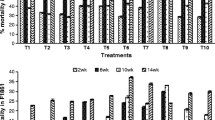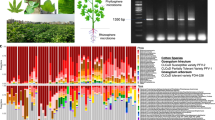Abstract
Aims
The effect of microbial preparations on plant growth and resistance to diseases depends on plant genotype and growth conditions limiting their use in agriculture. Various biocontrol effects, reported for the endophyte Methylobacterium sp. IMBG290, are possibly modulated through the endophyte community of the potato (Solanum tuberosum L.) host. In the current study, we analyzed growth promoting and biocontrol capacities of IMBG290 alone and when combined with commercial bacterial preparation under field conditions.
Methods
The effect of microbial inoculants on potato growth and disease prevalence was monitored during 2-year field experiment and matched with metagenomic analysis results of potato endophytic community.
Results
The effect of microbial inoculants on plant growth and disease prevalence varied from positive to negative depending on potato cultivar, bacterial treatment and environmental conditions. A cultivar-dependent synergistic effect of combined inoculation was observed. The positive effect of bacterial treatments was associated with a shift in the structure of communities of bacterial and fungal endophytes.
Conclusions
Cultivar-environment interaction associated with a shift in the endophytic microbial community play a role in the potato response to bacterial preparations. This should be considered when designing complex microbial inoculants.


Similar content being viewed by others
References
Abdo Z, Schüette UME, Bent SJ, Williams CJ, Forney LJ, Joyce P (2006) Statistical methods for characterizing diversity of microbial communities by analysis of terminal restriction fragment length polymorphisms of 16S rRNA genes. Environ Microbiol 8:929–938
Ardanov P, Sessitsch A, Häggman H, Kozyrovska N, Pirttilä AM (2012) Methylobacterium-induced endophyte community changes correspond with protection of plants against pathogen attack. PLoS ONE 7:e46802
Ardanov P, Ovcharenko L, Zaets I, Kozyrovska N, Pirttilä AM (2011) Endophytic bacteria enhancing growth and disease resistance of potato (Solanum tuberosum L.). Biol Control 56:43–49
Babalola OO (2010) Beneficial bacteria of agricultural importance. Biotechnol Lett 32:1559–1570
Barton J, Fowler SV, Gianotti AF, Winks CJ, de Beurs M, Arnold GC, Forrester G (2007) Successful biological control of mist flower (Ageratina riparia) in New Zealand: agent establishment, impact and benefits to the native flora. Biol Control 40:370–385
Berg G (2009) Plant-microbe interactions promoting plant growth and health: perspectives for controlled use of microorganisms in agriculture. Appl Microbiol Biotechnol 84:11–18
Chelius MK, Triplett EW (2001) The diversity of archaea and bacteria in association with the roots of Zea mays L. Microb Ecol 41:252–263
Choi JH, Kim JH, Daneial M, Lebeault JM (1989) Optimization of growth medium and poly-β-hydroxybutyric acid production from methanol in Methylobacterium organophilum. Korean J Appl Microbiol Bioeng 17:392–396
Choiseul J, Allen L, Carnegie SF (2006) Fungi causing dry tuber rots of seed potatoes in storage in Scotland. Potato Res. doi:10.1007/s11540-007-9020-y
Compant S, Duffy B, Nowak J, Clement C, Barka EA (2005) Use of plant growth-promoting bacteria for biocontrol of plant diseases: principles, mechanisms of action, and future prospects. Appl Environ Microbiol 71:4951–4959
Culman SW, Bukowski R, Gauch HG, Cadillo-Quiroz H, Buckley DH (2009) T-REX: software for the processing and analysis of T-RFLP data. BMC Bioinform. doi:10.1186/1471-2105-10-171
Diallo S, Crépin A, Barbey C, Orange N, Burini JF, Latour X (2011) Mechanisms and recent advances in biological control mediated through the potato rhizosphere. FEMS Microbiol Ecol 75:351–364
Edwards U, Rogall T, Blöcker H, Emde M, Böttger EC (1989) Isolation and direct complete nucleotide determination of entire genes. Characterization of a gene coding for 16S ribosomal RNA. Nucleic Acids Res 17:7843–7853
Friesen M (2011) Microbially mediated plant functional traits. Annu Rev Ecol Evol Syst. doi:10.1146/annurev-ecolsys-102710-145039
Gaiero JR, McCall CA, Thompson KA, Day NJ, Best AS, Dunfield KE (2013) Inside the root microbiome: bacterial root endophytes and plant growth promotion. Am J Bot 100:1738–1750
Gardes M, Bruns TD (1993) ITS primers with enhanced specificity for basidiomycetes – application to the identification of mycorrhizae and rusts. Mol Ecol 2:113–118
Grosch R, Dealtry S, Schreiter S, Berg G, Mendonça-Hagler L, Smalla K (2012) Biocontrol of Rhizoctonia solani: complex interaction of biocontrol strains, pathogen and indigenous microbial community in the rhizosphere of lettuce shown by molecular methods. Plant Soil. doi:10.1007/s11104-012-1239-y
Huber T, Faulkner G, Hugenholtz P (2004) Bellerophon: a program to detect chimeric sequences in multiple sequence alignments. Bioinformatics 20:2317–2319
Ikeda S, Kaneko T, Okubo T, Rallos LEE, Eda S, Mitsui H, Sato S, Nakamura Y, Tabata S, Minamisawa K (2009) Development of a bacterial cell enrichment method and its application to the community analysis in soybean stems. Microb Ecol 58:703–714
Kalitskyy P, Kravchenko, Sharapa M (2005) Food potato. Technology of cultivation. Fundamental regulation. State Committee for Technical Regulation and Consumer Policy of Ukraine, Kyiv
Kloepper JW, Ryu C (2006) Bacterial endophytes as elicitors of induced systemic resistance. In: Schulz BJE, Boyle CJC, Sieber TN (eds) Microbial root endophytes. Springer Berlin Heidelberg, Berlin, pp 33–52
Kozyrovska N, Negrutska V (2004) “Kleps” biological product for nutrition and protection of plants. Ukraine Patent 44189:15.12.2004
Nilsson RH, Abarenkov K, Veldre V, Nylinder S, De Wit P, Brosche S, Alfredsson JF, Ryberg M, Kristiansson E (2010) An open source chimera checker for the fungal ITS region. Mol Ecol Resour 10:1076–1081
O’Brien M, Mullins E (2009) Relevance of genetically modified crops in light of future environmental and legislative challenges to the agri-environment. Ann Appl Biol. doi:10.1111/j.1744-7348.2008.00304.x
Oksanen J, Blanchet FG, Kindt R, Legendre P, Minchin PR, O’Hara RB, Simpson GL, Solymos P, Stevens MHH, Wagner H (2013) Vegan: community ecology package. In: R package version 2.0-7. Available via CRAN http://CRAN.R-project.org/package=vegan Cited 10 Jul 2014
Podolich O, Ardanov P, Zaets I, Pirttilä AM, Kozyrovska N (2015) Reviving of the endophytic bacterial community as a putative mechanism of plant resistance. Plant Soil. doi:10.1007/s11104-014-2235-1
Podolich O, Laschevskyy V, Ovcharenko L, Kozyrovska N, Pirttilä AM (2009) Methylobacterium sp. resides in unculturable state in potato tissues in vitro and becomes culturable after induction by Pseudomonas fluorescens IMGB163. J Appl Microbiol 106:728–737
Reinhold-Hurek B, Hurek T (2011) Living inside plants: bacterial endophytes. Curr Opin Plant Biol 14:435–443
Rudrappa T, Biedrzycki ML, Bais HP (2008) Causes and consequences of plant-associated biofilms. FEMS Microbiol Ecol 64:153–166
Sessitsch A, Rasche R (2008) 16S rRNA based terminal restriction fragment length polymorphism (T-RFLP) and sequence analysis. In: Sorvari S, Pirttilä AM (eds) Prospects and applications for plant-associated microbes. A laboratory manual, part A: bacteria. Biobien Innovations, Turku, pp 23–30
Shaharoona B, Naveed M, Arshad M, Zahir ZA (2008) Fertilizer-dependent efficiency of Pseudomonads for improving growth, yield, and nutrient use efficiency of wheat (Triticum aestivum L.). Appl Microbiol Biotechnol 79:147–155
Snieškiene V, Baležentiene L, Stankevičiene A, Meškauskiene V (2012) Intensity of fungal diseases of small-leaved lime (Tilia cordata Mill.) across urban greeneries of Lithuania. J Food Agric Environ 10:988–993
Southern EM (1979) Measurement of DNA length by gel electrophoresis. Anal Biochem 100:319–323
Sullivan RF, White JF (2000) Phoma glomerata as a mycoparasite of powdery mildew. Appl Environ Microbiol 66:425–427
Thakore Y (2006) The biopesticide market for global agricultural use. Ind Biotechnol 2:194–208
Teslyuk PS, Sydorchuk VI (2011) Catalogue of potato varieties. Nadstyr’ya, Lutsk
Turnbull AL, Liu Y, Lazarovits G (2012) Isolation of bacteria from the rhizosphere and rhizoplane of potato (Solanum tuberosum) grown in two distinct soils using semi selective media and characterization of their biological properties. Am J Potato Res. doi:10.1007/s12230-012-9253-4
Velivelli SL, Sessitsch A, Prestwich BD (2015) The role of microbial inoculants in integrated crop management systems. Potato Res. doi:10.1007/s11540-014-9278-9
Wafaa MH, Lashin MS, El Azzazy AM (2012) Large scale production and pilot trails of Tilletiopsis pallescens for biocontrol of mango powdery mildew. Eur J Sci Res 67:194–214
Weyens N, Croes S, Dupae J, Newman L, van der Lelie D, Carleer R, Vangronsveld J (2010) Endophytic bacteria improve phytoremediation of Ni and TCE co-contamination. Environ Pollut 158:2422–2427
White TJ, Bruns TD, Lee S, Taylor J (1990) Analysis of phylogenetic relationship by amplification and direct sequencing of ribosomal RNA genes. In: Innis MA, Gelfond DH, Sainsky JJ, White TJ (eds) PCR protocol: a guide to method and applications. Academic, New York, pp 315–322
Xu XM, Jeffries P, Pautasso M, Jeger MJ (2011) Combined use of biocontrol agents to manage plant diseases in theory and practice. Phytopathology 101:1024–1031
Acknowledgments
The present work was supported by the University of Oulu and by the Finnish Doctoral Program in Plant Science.
Author information
Authors and Affiliations
Corresponding author
Additional information
Responsible Editor: Stéphane Compant.
Electronic supplementary material
Below is the link to the electronic supplementary material.
ESM 1
(DOC 269 kb)
Rights and permissions
About this article
Cite this article
Ardanov, P., Lyastchenko, S., Karppinen, K. et al. Effects of Methylobacterium sp. on emergence, yield, and disease prevalence in three cultivars of potato (Solanum tuberosum L.) were associated with the shift in endophytic microbial community. Plant Soil 405, 299–310 (2016). https://doi.org/10.1007/s11104-015-2500-y
Received:
Accepted:
Published:
Issue Date:
DOI: https://doi.org/10.1007/s11104-015-2500-y




